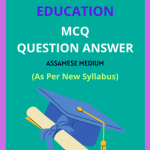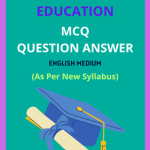Class 11 Education Chapter 2 Stages of Human Development The answer to each chapter is provided in the list so that you can easily browse throughout different chapters AHSEC Class 11 Education Chapter 2 Stages of Human Development, Class 11 Education Question Answer, HS 1st year Education Books Answer and select need one.
Class 11 Education Chapter 2 Stages of Human Development
Also, you can read the AHSEC book online in these sections Solutions by Expert Teachers as per AHSEC (CBSE) Book guidelines. These solutions are part of AHSEC All Subject Solutions. Here we have given Assam Board/NCERT Class 11 Education Chapter 2 Stages of Human Development Solutions for All Subject, You can practice these here.
Stages of Human Development
Chapter: 2
EDUCATION
TEXTUAL QUESTION & ANSWER
1. What is the difference between growth and development?
Ans: Growth means an increase in size implies all around changes in shape, from or structure resulting in improved worth or functioning. It means changes in the qualitative aspects of human life.
2. How many stages of development human life?
Ans: According to Dr. Earnest Jones there are four stages of human development.
They are :
(1) Infancy – birth to 5 years
(2) Childhood – 6-12 years
(3) Adolescence – 12-18 years
(4) Maturity or Adulthood – above 18 years.
3. What is the name of the stage from birth to 5 years?
Ans: Infancy.
4. What is the name of the stage between 12 to 18 years of age?
Ans: Adolescence.
5. Write three characteristics of development.
Ans: The three characteristic of development are :
(1) The growth rate of different physical and mental aspects are different. Every individual reaches maturity at different times.
(2) Development proceeds from general to specific response a child first uses it’s whole body to react to some situation and gradually it learns to become specific.
(3) The interaction of both heredity and environment leads to the proper development of an individual. These two factors work together from the very time of conception.
6. Why is childhood called the age of schooling?
Ans: During this stage, the child becomes capable of going to school. Physical, mental, intellectual and social, all these developments make the child completely fit for school life. That’s why childhood is called the age of schooling.
7. Why do infants frequently ask questions?
Ans: Because the child becomes curious to know the what, whom and where of every strange and interesting things or rate object, custom etc.
8. What is infancy?
Ans: Infancy is the first stage of life. Infancy begins after birth and continues, till the five years of growth and development.
9. Write five characteristics of infancy?
Ans: The main five characteristics of infancy are:
(1) Rapid or quick physical growth.
(2) Physical dependence
(3) Rapid motor development.
(4) Playfulness
(5) Sensory development.
10. What is childhood? Write three characteristics of childhood.
Ans: Childhood is the second stage of growth and development after birth. In general speaking childhood is the stage of growth and development which comprises the age limit from six years to twelve years.
There characteristics of childhood :
(1) Rapid physical development.
(2) Intellectual ability
(3) Social development
11. What is adolescence? Why is adolescence called the period of storm and stress?
Ans: Adolescence is the period of human growth from 12-18 years of age. It is said to be the most crucial and important period of human life. There are changes from all sides- physical, mental, sexual, emotional, social and moral.
Professor Stanly Hall, the great US psychologist has, described this period as one of the stages of the most critical period of the life. In other words, it is a time of great “Strife and Strain, when the adolescent meets with a “clash between his previous scheme of thoughts and his new experiences.
12. Mention five psycho-physical needs of infancy.
Ans: The five psycho-physical needs of infancy are:
(1) Need of play
(2) Need of emotional security
(3) Need if satisfying security
(4) Need of status
(5) Need of freedom
| Sl. No. | Contents |
| Chapter 1 | Concept and Aims of Education |
| Chapter 2 | Stages of Human Development |
| Chapter 3 | School and its Organizations |
| Chapter 4 (A) | Psychology and Education |
| Chapter 4 (B) | Education Psychology and its Significance |
| Chapter 5 | Physical Basis of Mental Life |
| Chapter 6 | Bases and Direction of Human Behaviour |
| Chapter 7 | Primary Education in India and Assam |
13. Mention five psycho-physical needs of adolescence.
Ans: The five psycho-physical needs of adolescence are:
(1) Sex Need
(2) Security Need
(3) Gregarious need
(4) Adventure need
(5) Need for social- approval.
14. Write five problems of adolescence.
Ans: The five problems of adolescence are:
(1) Sex – problem
(2) Problem of Identity crisis.
(3) Emotional problem
(4) Social problem
(5) Educational problem
15. What is gang loyalty?
Ans: Gang loyalty is one of the main factors of later childhood. Due to the instinct of group consciousness, the children become social and they usually try to become a member of some gangs. They are very faithful to the gang to which he or she belongs. They do not even hesitate to tell lies to their parents or teacher for the sake of their gang royalty.
16. What is hetero-sexuality?
Ans: Sex is the fundamental fact of adolescence. They develop into hetero sexuality which make them anxious to know about sex and the biological changes going on in the body. Sometimes to satisfy their sex-curiosity, the boy or girl may develop some physical relationship and then repent it.
17. What is animation?
Ans: Animation is a belief in a supernatural power that organises and animates the material universe. It is the attribution of a living soul to plants, animal objects and natural phenomena.
18. Write briefly about the educational provision of infancy.
Ans: After birth, infancy is the first stage of life. Infancy begins after birth and continues till the five years of growth and development. Some psychologists have divided infancy into two parts I. e. early infancy and later infancy. From the moment of birth till two years of life is the first phase of infancy which is called as early infancy from two years of age to 5 years is the second phase which is called the later infancy.
The first phase i. e. early infancy has special significance from the point of growth and development of the child. During this phase the child has to learn to adjust with the totally new environment after coming out from the mother’s abdomen. This is the formative period of growing human life and the stage at which formal education should begin . Gessel and Megrow divided the educational developments of infants into eight stages viz.
(1) Physical development
(2) Language development
(3) Development of adjustments process
(4) Individual development
(5)Social Development
(6) Sensory development
(7) Intellectual development
(8) Development of imagination.
19. Write briefly about the educational provision of childhood.
Ans: Primary education caters to the educational needs of children above the stage of infancy. It constitutes a very important part of the total structures of education. It is also the first phase of a child’s formal education. Because it is at this stage that the young child starts attending a formal education institution for formal course of study. The main function of primary school is to impart instructions in reading, writing and arithmetic.
Because these schools also give elementary knowledge of the history, Geography, Nature study, Handwork, Drawing etc. In short, primary school instructions provide a disposable basis for secondary education. Education of this stage is given highest priority on the ground of democracy and social justice and for improving the occupational competency of workers all over the world.
20. Write briefly about the educational provision of adolescence?
Ans: Adolescence is the period of human growth from 12-18 years of age. One the other hand, secondary education is the stage of education, which is given after primary education and before higher education. It is generally given to the students of the age group of 11-18 years. The students are in their adolescence period at this stage. Secondary education occupies a great place in the education system of a country. It helps the students to mould their character and personality and prepare them for the future sociality. It also helps them to give fall expression to their abilities. As the students are prepared to receive higher education after this stage, the education at this stage should be framed to help the students acquire both knowledge and skills to lead a better economic life.
21. Write briefly about the influence of home on child’s development?
Ans: It is often said that the advancement of a nation is mirrored in the condition of its homes as families. Historically of the society, Rosen kraz says- The education institution of the society, Rosen over says- The family is the organic starting point of education.
It is so to say the ideal school of life. The healthy influence of home or family goes a long way in moulding and educating the child’s mind to reach a particular ideal. Normally it is at home with his mother that the child learns to walk, to distinguish between meum and tuum to learn the simple properties of the things around him to take his bearings amid his physical and social surroundings and to form some of the deepest of human affections. The drawing out of the child’s inherent capacities and innate instincts and their guidance or education begins in the home environments.

Hi, I’m Dev Kirtonia, Founder & CEO of Dev Library. A website that provides all SCERT, NCERT 3 to 12, and BA, B.com, B.Sc, and Computer Science with Post Graduate Notes & Suggestions, Novel, eBooks, Biography, Quotes, Study Materials, and more.






Dev Library is a very helpful website.